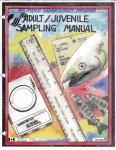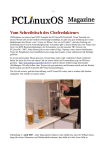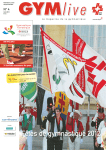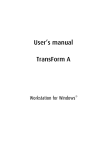Download User's Manual and Map Sheets
Transcript
Habitat and Development Classification System User's Manual and Map Sheets March 2000 Prepared for: FISHERIES AND OCEANS CANADA Habitat and Enhancement Branch South Coast Division 3225 Stephenson Point Road Nanaimo, B.C. V9T 1K3 Prepared by: ECL ENVIROWEST CONSULTANTS LIMITED 204-800 McBride Boulevard New Westminster, BC, V3L 2B8 Correct Document Citation: Adams, M.A., and K.E. Asp. 2000. Habitat and Development Classification System: User’s Manual and Map Sheets. Courtenay River Estuary Management Plan. Prepared by ECL Envirowest Consultants Limited. Prepared for Fisheries and Oceans Canada, Nanaimo, B.C. 8 p +14 map sheets. TABLE OF CONTENTS 1.0 INTRODUCTION ................................................................................................ 1 2.0 BACKGROUND.................................................................................................. 2 3.0 HABITAT AND DEVELOPMENT CLASSIFICATION SYSTEM ......................... 5 3.1 3.2 3.3 Definitions...................................................................................................... 5 Application..................................................................................................... 7 Habitat Classification Review ........................................................................ 7 FIGURE 1 Habitat and Development Classification Definitions................................................. 6 APPENDIX A Habitat Classification Map Sheets Courtenay River Estuary Management Plan Habitat and Development Classification System: User’s Manual and Map Sheets Page I 1.0 INTRODUCTION Fisheries and Oceans Canada (FOC), in collaboration with local, provincial and other federal government departments and organizations, commenced development of a comprehensive environmental management plan for the Courtenay River estuary in April, 1998. The effective management of environmental resources is in large part dependent upon the identification and implementation of programs that pursue actions on specific issues of management concern. Each action program aspires to address one to several objectives. A program may also pursue one to several actions to achieve its objective(s). The use of action programs is a practical approach towards the effective management of environmental resources. The Plant, Fish and Wildlife Habitat Action Program is one of eight Action Programs identified by the Courtenay River Estuary Management Plan (CREMP). Several objectives are identified for this action program, including: "to maintain and improve, where possible, the existing habitat base in the estuary to support viable and productive populations of plants, fish and wildlife". The Plant, Fish and Wildlife Habitat Action Program is somewhat unique in that it considers the estuary as habitat not only for fish and wildlife, but also for plants. Consideration is afforded the management of endangered or threatened species, as well as the management of non-native invasive species that threaten the fidelity of the species membership of plant communities with natural assemblages of native plants. To facilitate achievement of the referenced objective, the Plant, Fish and Wildlife Action Program identifies as an action the development and implementation of a habitat and development classification system for the estuary. This manual and accompanying map sheets is the product of this action. Courtenay River Estuary Management Plan Habitat and Development Classification System: User’s Manual and Map Sheets Page 1 2.0 BACKGROUND The classification of habitats and the identification of development constraints associated with each classification is an important component of the effective management of environmental resources within any geographical area. The classification is according to the functional habitat values environments sustain for plants, fish and wildlife. The classification of habitats within the Fraser River estuary during the mid-1980's was one of the first management initiatives of the newly fledged Fraser River Estuary Management Program (FREMP). The FREMP colour-coded system classifies the overall habitat value of the estuarine shoreline and identifies development constraints associated with each classification. The definition of habitat is limited to functional habitat values provided by estuarine environments for fish and wildlife. Development constraints apply to all components of development, including design, construction and operation. The design component of development consists of the physical configuration of the project. Impacts attributable to design are typically associated with the footprint of structures, or other changes in the physical environment, such as shading and the alteration of flows and currents. The construction component of development includes those elements separate from the design, specific to the physical installation of works. Typical elements of construction include access and working corridors for machinery, storage of construction materials, handling of hazardous wastes, and installation of interim structures to facilitate construction. The operation component of development is associated with use related activities, such as refuelling within marinas, handling and storage of materials in bulk loading facilities, or vehicle use of parking lots. All components of development can negatively impact environmental resources. The FREMP habitat classification system is a three tiered colour-coded system: habitats are colour-coded red, yellow or green. Red-coded shorelines sustain highly productive fish and wildlife habitats. Development is not permitted unless project design, construction and operation can demonstrate that the functional capacity of habitats is not negatively impacted by development. It is worthy to note that all constructed habitats, whether part of habitat enhancement/restoration/creation initiatives by environmental agencies, or created as part of a habitat compensation program associated with development, are automatically coded red. Yellow-coded shorelines sustain moderately productive habitats. Development is permitted contingent upon the satisfactory mitigation of development associated impacts. Unmitigable impacts must be compensated for through the construction of replacement habitats. Green-coded shorelines are characterized by habitats of low productivity. Development is governed by environmentally sustainable design, construction and operation. Colour-code related constraints placed upon development are based upon the practical feasibility of mitigating impacts to productive fish and wildlife habitats, and upon federal Courtenay River Estuary Management Plan Habitat and Development Classification System: User’s Manual and Map Sheets Page 2 and provincial legislation and policies that empower resource agencies to protect plant, fish and wildlife habitats. The original classification of habitats within the FREMP jurisdictional area was deficient in its consideration of riparian and subtidal habitats. Firstly, with regard to riparian habitats, the shoreline classification considered only that portion of the riparian environment that intercepted the normal high water mark. The unit of currency for riparian habitat was linear, rather than the areal currency utilized for intertidal habitats. Habitats contiguous with the immediate riparian environment, such as early to mid seral woodlands of adjacent undeveloped uplands, were not considered by the original classification. Recent efforts by regulatory agencies to extend the habitat classification landward, to include undeveloped upland features contiguous with the immediate shoreline environment, have attempted to remedy this original oversight; however, in the interim, several important habitats have been lost to development without adequate mitigation or compensation. Secondly, the classification did not address nearshore subtidal habitats. The implication of this omission upon habitat management is most apparent at Roberts Bank at the delta front, where expansive eelgrass beds occur between the Coal Port causeway and the Tsawwassen ferry terminal causeway. Expansive eelgrass beds occur within the nearshore subtidal environment of the intercauseway area. Although acknowledged by environmental regulatory agencies as sustaining critical habitat functions for fish and wildlife, the lack of classification for this important habitat type has contributed to an ambiguity as to what is permitted in terms of port development and maintenance activities. At least on one occasion, an extensive meadow of eelgrass was dredged as part of berth expansion. Proper consideration was not afforded the subtidal environment as the intertidal component of the causeway was coloured coded yellow; without utilizing a detailed assessment of impacts, including a biophysical inventory of prospectively impacted environments, the classification system failed to alert regulatory agency personnel of the real impacts associated with berth expansion. The original classification of habitats was also compromised by the subjectivity of colourcode assignments. The original classification was conducted by Fisheries and Oceans Canada, Ministry of Environment, Lands and Parks, Canadian Wildlife Service (Environment Canada), Fraser River Harbour Commission (within Fraser Port), and the North Fraser River Harbour Commission (within North Fraser Port). In essence, classification was achieved through a consensus of opinion; quantitative information was rarely utilized. The approach often failed in the allocation of a colour code for habitats perceived as possessing values intermediate of yellow and red classifications. A strong emphasis was placed on the presence and absence of vegetation. As a result, non-vegetated habitats, such as intertidal mudflats, were often classified yellow, despite their intrinsic habitat value, and their functional linkage with proximal habitats, such as intertidal marsh and riparian woodland. Despite deficiencies in the original classification of habitats, the FREMP classification system is an important component of the FREMP Project Review Process. The colour coding of habitats provides for an initial assessment of the environmental feasibility of contemplated development for a particular segment of shoreline. In most instances, project Courtenay River Estuary Management Plan Habitat and Development Classification System: User’s Manual and Map Sheets Page 3 applications are required to include a detailed biophysical inventory of the project site. The inventory often forms the basis for impact mitigation associated with the design, construction and operation of a project. For yellow coded shoreline environments, the inventory is often utilized as the basis of habitats to be preserved and protected. Recognizing ongoing activities within the FREMP planning area, such as habitat enhancement/restoration/creation and shoreline developments, colour codes are reviewed under the auspices of FREMP's Habitat Classification Review Process. Specific shoreline codings are nominated for review are re-evaluated based on current habitat values. Courtenay River Estuary Management Plan Habitat and Development Classification System: User’s Manual and Map Sheets Page 4 3.0 HABITAT AND DEVELOPMENT CLASSIFICTION SYSTEM 3.1 Definitions The Habitat and Development Classification System includes both habitat and development terminology in recognition of the emphasis on both habitat valuation and environmental criteria for development. The colour-code based classifications, and respective habitat valuations and associated environmental criteria for project design, construction and operation, are presented in Figure 1. Development is defined as any activity or facility associated with recreational, agricultural, residential, commercial and industrial uses that have the potential to impact environmental resources. The potential to impact habitat is assessed and determined by the Environmental Review Committee of the Courtenay River Estuary Management Plan. A three-tiered habitat classification approach is applied by CREMP. The three-tiered system considers separate classifications for riparian, foreshore and below low water habitat zones. The riparian habitat zone commences at the high water elevation and continues landward. Due to the diversity of land uses within upland environments of the planning area, the landward extent of the riparian zone changes with location in the estuary. In most instances, a detailed biophysical inventory, conducted as part of an application for works submitted to the CREMP Project Review Process, will define the landward extent of the functional riparian zone for plants, fish and wildlife. The valuation afforded the riparian habitat zone by current classifications recognizes the obvious functional values of these habitats. The foreshore habitat zone occupies that portion of the shoreline environment between the high water and low water elevations. For the Courtenay River, and those portions of the Puntledge, Tsolum and Trent rivers and other watercourses that occur within the CREMP planning area, high and low water elevations are either a sole function of seasonal flows or a combination of seasonal flows and tidal processes. Water levels within the remaining portions of the planning area, beyond the hydraulic channels and alluvial fans of watercourses, are predominantly a function of tidal processes. The below low water zone comprises that portion of the shoreline environment below low water to an elevation that is 10 metres below the low water elevation. The entire beds of all watercourses that occur within the planning area are encompassed by this habitat zone. The below low water habitat zone also encompasses all nearshore subtidal eelgrass beds that occur within the planning area. Courtenay River Estuary Management Plan Habitat and Development Classification System: User’s Manual and Map Sheets Page 5 HABITAT AND DEVELOPMENT CLASSIFICATION CLASSIFICATION HABITAT VALUE ENVIRONMENTAL CRITERIA FOR DEVELOPMENT Red High; high biological productivity associated with a relatively complex biophysical environment; critical habitat functions are sustained onsite or as part of a broader continuum Development must demonstrate impact mitigation sufficient to ensure that existing habitats are not harmfully impacted Yellow Intermediate; intermediate biological productivity associated with a relatively simple biophysical environment; important habitat functions are sustained onsite Development must demonstrate impact mitigation to the greatest extent practical; residual harmful impacts to existing habitats to be compensated for through creation of replacement habitats Green Low; low productivity is associated with a modified biophysical environment to such an extent that biological productivity is not significant from a habitat resource perspective Development must demonstrate impact mitigation and sound environmental design, construction and operation RIPARIAN HABITAT ZONE CLASSIFICATION SHORELINE FORESHORE HABITAT ZONE CLASSIFICATION BELOW LOW WATER HABITAT ZONE CLASSIFICATION RIPARIAN HABITAT ZONE FORESHORE HABITAT ZONE BELOW LOW WATER HABITAT ZONE HIGH WATER LOW WATER (SHORELINE) -10 METRES BELOW LOW WATER FIGURE 1. HABITAT AND DEVELOPMENT CLASSIFICATION DEFINITIONS 3.2 Application This manual, including the attached map sheets, is a component of the Courtenay River Estuary Management Plan. Further, it is a fish habitat management policy document of the Department of Fisheries and Oceans. The habitat values delineated by the map sheets directly reflect fish habitat values. Plant and wildlife habitat values are intricately linked or correspond to the values sustained by the shoreline as fish habitat. As for the FREMP classification system, colour-code related constraints placed upon development are based upon the practical feasibility of mitigating impacts to plant, fish and wildlife habitats, and upon federal and provincial legislation and policies that empower resource agencies to protect plant, fish and wildlife habitats. The habitat classifications are not a substitute for detailed valuations of environmental resources that typically accompany comprehensive environmental impact assessments conducted under the auspices of municipal, provincial and federal legislation and policies. Development proponents are advised to contact municipal, provincial and federal authorities as to the application of the classifications in the environmental review process administered by the respective authority. The classifications are utilized by the Environmental Review Committee of the Courtenay River Estuary Management Plan to assess the prospect of significant impacts to environmental resources. 3.3 Habitat Classification Review Habitat classifications are reviewed on an annual basis contingent upon a request for review submitted to the Environmental Review Committee by a member agency of the Courtenay River Estuary Management Plan. The reviews will be based on new biophysical information or changes in site conditions as they relate to a particular shoreline segment. The habitat classifications currently presented represent a critical assessment of biological productivity sustained by shoreline environments. Typically, existing uses did not affect the outcome of the assessment; however, in some instances, existing uses had to be considered due to their limitation upon the biological productivity of affected habitats. Common examples include dredge basins of marinas and the navigation channel of the Courtenay River. Decommissioning of such uses may result in an upgrade in the classification of affected habitats. A detailed bioinventory of the planning area, as identified as an action by the Plant, Fish and Wildlife Habitat Action Program, will provide information that will allow further definition of classified habitat types. The current classifications have been assigned based upon existing biophysical information and site assessments and valuations conducted by Fisheries and Oceans Canada and their representatives. A detailed bioinventory, whereby detailed survey data are collected, would facilitate the definition and mapping of habitat types (e.g. intertidal marsh, riparian woodland, etc.) throughout the planning area. The mapping would define the specific habitat types to which habitat classifications apply. Courtenay River Estuary Management Plan Habitat and Development Classification System: User’s Manual and Map Sheets Page 7 The restoration, enhancement and creation of habitat types will typically be applied to shoreline environments that sustain low (green coded) to moderate (yellow coded) habitat values. These activities will result in the establishment of high habitat values. Restored, enhanced and created habitats, accordingly, are reclassified as red coded habitats. Courtenay River Estuary Management Plan Habitat and Development Classification System: User’s Manual and Map Sheets Page 8 Appendix A Habitat Classification Map Sheets , I Y RIVER I \ I , - - -- - - -- - - - / \ I Estuarv M'lI1agement Plan . I HABITAT AND DEVELOPMENT CLASSIFICATION \ I ..... • I ClASSIF ICATION £NVIROI' MF.NT AI. CRITE"'" fOR OEV£l Ol'MENT I I I I I I I I I I I • \ \ '00 - - - _ lilgo, I'>IgtI (IfOdUClMty .0S0Ciated with • 'e\atNely CQrrIIlIo. biophys.iel>l "",,""""""'t ctiti<:ol \ - h<I_Iuo.,,",,, ...,., _ \ \ , " , _ 0 , W. ... "-.»IO I.A..... .. ~_..tod_. ,o<ttOoto/)' VrojM IMu\>I''- ~ ~nt Iuo>ctiox...... _ I I I / I I I I I I I Lew. \oWprodo,>cIMty. · 'W_ I \ 10 '" I J I I I I I -- \ I I I I l I I I I I I I I I I I - - - - -- - - - ~CRlllIon o.r. I, ." .~""""",,,,,,,,,,,,,, ~ ~Ion ..... """""" tIooIgn, _ oonov_..-.I ........!fo,1 \ \ \ \ _ \ ,""1 \ , \, \ .+. , \ \\ I "" \ \ ~ _ _ 11'_ , , _.... ""'mM ~ 10 e>.1'*'11 "",,"_10 be \ \ \ 0.. ....... ' ... 1 ""'" dool .......10 Onpoo:t ~ 10 thO gr_t LOWW,",TERHABrTM WfTflJl LE:.s.E AAiA \ \ " 1_ ..... MI "",oigo_l""". \ \ ...,..,Ied -.01 ........... """Pi" ,. .... YfllOW CCOEO BELOW \ ~ I II ~ ~ \ I ""n,J t;os>'"i)*tI ,"",~"'. ' . ~ scdo an O>lon< """ witro • \ I "ro ""' .... ~ of~ l.iI-' I I """act e_ ' etMl~_. _ ~oos/I. I I De,...,..,_.1 """,I """",,,tuM. mI~ ~ 10 onsIlO '" ... par! of. " ' _ I I ~8 1 \ \ \ \ \ ,~, \ ~ \~ • ,, F i~h e"es Pechcs and Ocecrs et Oceans - "- , I Y RIVER I \ I I I \; I I I I I / HABITAT AND DEVELOPMENT CLASS IF ICATION \ \ \ I , FOIl DEVElOPMENT ,~ --- HOI. IliQtI ~ 1"00,""",,1)' \ , , •• _ " " .. 111 • .... "" .. , """"""x biopOy. icaI .... ~n~ crI!Ical _ - "",,110 0< "" ... I ~ \ \ tOophyo<col "",,,,, .. ,,,,1; importanl habitat fuocIiono .... ..,~ons1!. McDONALD ROAD • hOOita1 \YELlOWCOO€O saCI'll ', LOW WATER HABITAT ~.mtltllEAS.E \ ,, e.'",," noM.to 1<le1''''' ..U.''' ,_'*\IfM1e., Mm'IIu! ~t ...... "'"""'" ~ 10 1!>0 .,.... ..-~; ~ to oxl.'"'Il haMal, to t>O ~ fOIlMrougI1 " ' _ =ria''''' ,,"», ~ <!ornoo....m<>1if'8d t>ioI>nysIcaI,,",""O_ Impact ~11oo """ sound to WCIl an _ <hat t>ioIoQIc3I ",,""""""181 ~Mogn, oomInJcIioo _ operation prooOCl"'ity i$f'> (ll .igtif>cant from • low'. law pr""""''''1)/ i•• ~. ", , ~t """" <b ... "",,,,, irrIpacI m~~ " " _ , 10 1M! 0";'1"", a re roo! harmful>' ~ of repla<:emenl habil2t • •• I fu<>Clion. ore "", ...!ned part 01 • ~ I'''.''me(~... in~ t>doo;;JIcaI """"""jlllty •• oocta,-" ",1111 a "'la!iv&Iy \\ I, ENVIRONMEJITAL CRITERIA HAIlITAT VALUE CLASSIFICATION \ I I , \ 1\ I Estuary Management Plan , • \ ,, I \ \ , ,osource ~ve AREA , \ \, \ \, \ \ , \ \ ,, \ \, \ \ IAARCH 200!1 \\ \ I.I \ , \, I \ \, , \ ~ / 7 \ \ • • \• \, \ \ .." \ \ \ \ \ \ \ • \ , \ I \, \ , \ \ \ \ / , • \ \ / • \ • \ \ \ \ \ \ \ \ \ • \ \ \ \ \ Peches et Oc eans \ \ ... .+. , • F ,sh~rr ~s a o d OCean5 I • ! I \ I •I I I ' \ \ \ I MAP 5

































